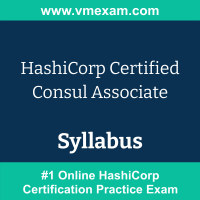 The HashiCorp Consul Associate exam preparation guide is designed to provide candidates with necessary information about the Consul Associate exam. It includes exam summary, sample questions, practice test, objectives and ways to interpret the exam objectives to enable candidates to assess the types of questions-answers that may be asked during the HashiCorp Certified - Consul Associate exam.
The HashiCorp Consul Associate exam preparation guide is designed to provide candidates with necessary information about the Consul Associate exam. It includes exam summary, sample questions, practice test, objectives and ways to interpret the exam objectives to enable candidates to assess the types of questions-answers that may be asked during the HashiCorp Certified - Consul Associate exam.
It is recommended for all the candidates to refer the Consul Associate objectives and sample questions provided in this preparation guide. The HashiCorp Consul Associate certification is mainly targeted to the candidates who want to build their career in Security Automation domain and demonstrate their expertise. We suggest you to use practice exam listed in this cert guide to get used to with exam environment and identify the knowledge areas where you need more work prior to taking the actual HashiCorp Certified Consul Associate exam.
HashiCorp Consul Associate Exam Summary:
|
Exam Name
|
HashiCorp Certified Consul Associate |
| Exam Code | Consul Associate |
| Exam Price | $70.5 USD |
| Duration | 60 minutes |
| Number of Questions | 57 |
| Passing Score | Pass / Fail (Approx 70%) |
| Recommended Training / Books | Prepare for the exam |
| Schedule Exam | Cloud Engineer Certification Exam Portal |
| Sample Questions | HashiCorp Consul Associate Sample Questions |
| Recommended Practice | HashiCorp Certified - Consul Associate Practice Test |
HashiCorp Consul Associate Syllabus:
| Section | Objectives |
|---|---|
| Understand the pillars of service networking |
- Understand how Consul discovers, tracks, and monitors the health of services - Explain how Consul secures service to service communication - Summarize how Consul controls access to services at point of entry - Discuss how Consul automates networking tasks |
| Describe Consul architecture |
- Identify Consul datacenter components including agents and communication protocols - Review Consul server high availability & scalability options - Differentiate between server agents and data plane components (client agents and Consul Dataplane) - Understand that Consul can run on multiple platforms |
| Deploy a single datacenter |
- Configure, bootstrap, and start Consul server agents - Configure and start Consul client agents - Configure and start Consul on Kubernetes - Explain Consul agent join methods and behavior |
| Register services and use service discovery |
- Interpret a service registration - Differentiate between service registration methods - Understand service health check configuration options and behaviors - Query Consul's service catalog via CLI, API, UI, and/or DNS, and interpret the results - Interpret & use prepared queries |
| Use Consul service mesh |
- Consider high level architecture & key benefits of Consul service mesh - Understand Consul service mesh intentions & when to use them - Apply proxy configuration options within Consul service mesh |
| Secure agent communication |
- Understand Consul security/threat model - Differentiate certificate types needed for TLS encryption - Interpret TLS encryption settings & intended use - Configure gossip encryption |
| Secure services with basic access control lists (ACLs) |
- Understand Consul ACL system components and usage - Create and configure ACL policies and tokens - Use ACL tokens to communicate securely with Consul services and agents |
| Secure and connect service mesh applications |
- Use Consul gateways to securely connect and access services into, out of, and within the service mesh - Understand how to enable communication between multiple Consul datacenters |
| Monitor Consul |
- Describe Consul service mesh observability - Review Consul datacenter observability |
| Operate and maintain Consul |
- Manage Consul servers - Maintain Consul communications security - Backup and restore Consul cluster state - Understand Consul datacenter troubleshooting options |
